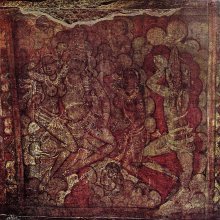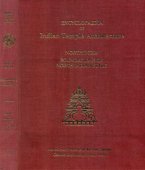Rashtrakuta, Rāṣṭrakūṭa: 8 definitions
Introduction:
Rashtrakuta means something in Jainism, Prakrit, Hinduism, Sanskrit, the history of ancient India. If you want to know the exact meaning, history, etymology or English translation of this term then check out the descriptions on this page. Add your comment or reference to a book if you want to contribute to this summary article.
The Sanskrit term Rāṣṭrakūṭa can be transliterated into English as Rastrakuta or Rashtrakuta, using the IAST transliteration scheme (?).
Images (photo gallery)
In Jainism
General definition (in Jainism)
Source: HereNow4U: Jainism in Andhra PradeshJainism had its hey-day during the reign of the Rashtrakutas (rāṣṭrakūṭa) (A.D. 700-1000). This assumption is supported by literary and epigraphical evidences. The Rashtrakutas had their capital in Mālkhēd (Manyakheta; mānyakheṭa); they had jurisdiction over many parts of Andhra. During the Rashtrakuta period, art and literature flourished and Jaina contribution was considerable. Amōgha-varṣa or Nṛpatuṅga (A.D. 814-78), himself, was a great scholar and promoted scholarship. He died as a Jaina.

Jainism is an Indian religion of Dharma whose doctrine revolves around harmlessness (ahimsa) towards every living being. The two major branches (Digambara and Svetambara) of Jainism stimulate self-control (or, shramana, ‘self-reliance’) and spiritual development through a path of peace for the soul to progess to the ultimate goal.
India history and geography
Source: What is India: Inscriptions of the ŚilāhārasRāṣṭrakūṭa (राष्ट्रकूट) is mentioned in the Paṭṭaṇakuḍi plates of Avasara II.—“Wonderful is that vaṃśa (family) of the Rāṣṭrakūṭa lords, which is the ornamental mark of the race of Yadu−which, unlike the ordinary vaṃśa (bamboo), has not risen to power after destroying (other members of ) the family unlike the ordinary bamboo (vaṃṡa) which comes out after splitting the ground; which gives no shelter to drunkards as the bamboo does to the bees; which is never opposed to religion as the bamboo is curved by nature”.
These copper plates were found by a Brāhmaṇa of Khārepāṭan, a town in the Devagaḍ tālukā of the Ratnāgiri District. The inscription refers itself to the reign of the Śilāra king, Māṇḍalika Raṭṭarāja. As his predecessors were loyal feudatories of the Rāṣṭrakūṭas, it gives first the genealogy of that family from Dantidurga to Kakkala. The inscription is dated, in lines 41-42, on the full-moon tithi of Jyeṣṭha in the śaka year 930, the cyclic year being Kīlaka.
Source: Cologne Digital Sanskrit Dictionaries: Indian Epigraphical GlossaryRāṣṭrakūṭa.—(EI 8-3), same as Rāṣṭra-mahattara; either the officer in charge of a territorial unit called rāṣṭra or, more pro- bably, a member of the administrative council of a rāṣṭra; cf. Grāma-kūṭa; also Deśakūṭa (IA 7). (EI 9), interpreted as ‘the headman of a village’. (EI 24), according to some, a land-holder. (CII 4; HD), interpreted as ‘the head of a district or sub- division’; cf. JBBRAS, Vol. XVI, p. 117. Note: rāṣṭrakūṭa is defined in the “Indian epigraphical glossary” as it can be found on ancient inscriptions commonly written in Sanskrit, Prakrit or Dravidian languages.
Source: Shodhganga: Elements of Art and Architecture in the Trtiyakhanda of the Visnudharmottarapurana (history)Rashtrakuta refers to a certain period in the history of Indian Art.—The chronological order of the development of Indian Art as stated in The Heritage of Indian Art is as follows—[...] 12. Rāstrakūṭa Dynesty contains the architecture of Kailasha temple at Ellora, Siva temple situated in the Elephanta caves of Maharashtra etc. The Rāstrakūṭa Dynesty belongs to the period from 757A.D to 973 A.D.

The history of India traces the identification of countries, villages, towns and other regions of India, as well as mythology, zoology, royal dynasties, rulers, tribes, local festivities and traditions and regional languages. Ancient India enjoyed religious freedom and encourages the path of Dharma, a concept common to Buddhism, Hinduism, and Jainism.
Languages of India and abroad
Sanskrit dictionary
Source: Cologne Digital Sanskrit Dictionaries: Monier-Williams Sanskrit-English Dictionary1) Rāṣṭrakūṭa (राष्ट्रकूट):—[=rāṣṭra-kūṭa] [from rāṣṭra] m. Name of a man, [Hemacandra’s Pariśiṣṭaparvan]
2) [v.s. ...] of a people, [Inscriptions]
[Sanskrit to German]
Sanskrit, also spelled संस्कृतम् (saṃskṛtam), is an ancient language of India commonly seen as the grandmother of the Indo-European language family (even English!). Closely allied with Prakrit and Pali, Sanskrit is more exhaustive in both grammar and terms and has the most extensive collection of literature in the world, greatly surpassing its sister-languages Greek and Latin.
Kannada-English dictionary
Source: Alar: Kannada-English corpusRāṣṭrakūṭa (ರಾಷ್ಟ್ರಕೂಟ):—[noun] one of the dynasties that ruled parts of Karnāṭaka.
Kannada is a Dravidian language (as opposed to the Indo-European language family) mainly spoken in the southwestern region of India.
See also (Relevant definitions)
Partial matches: Rashtra, Kuta.
Full-text (+88): Manyakheta, Amoghavarsha, Irattar, Rashtroda, Akalavarsha, Karka, Krishna, Bankapura, Mangallu, Khetakamandala, Latadesha, Gunda, Yuddhamalla, Govindaraja, Kopparakabhukti, Kopparaka, Lata, Pratishthana, Dinanatha suri, Pratishthanabhukti.
Relevant text
Search found 20 books and stories containing Rashtrakuta, Rāṣṭrakūṭa, Rastrakuta, Rashtra-kuta, Rāṣṭra-kūṭa, Rastra-kuta, Raṣṭrakūṭa, Raṣṭra-kūṭa; (plurals include: Rashtrakutas, Rāṣṭrakūṭas, Rastrakutas, kutas, kūṭas, Raṣṭrakūṭas). You can also click to the full overview containing English textual excerpts. Below are direct links for the most relevant articles:
Impact of Vedic Culture on Society (by Kaushik Acharya)
Mingling of Cultures (L): The Rāṣṭrakūṭas < [Chapter 4]
Chart: Religious beliefs of the Kings who ruled in Northern India < [Chapter 4]
Sanskrit Inscriptions (J): The Rāṣṭrakūṭas < [Chapter 3]
Early Chola Temples (by S. R. Balasubrahmanyam)
Temples in Gramam (Mudiyur) < [Chapter II - Temples of Parantaka I’s Time]
Introduction < [Chapter I - Parantaka I (Madirai-Konda Parakesari)]
Temples in Tiruvamattur < [Chapter II - Temples of Parantaka I’s Time]
Matangalila and Hastyayurveda (study) (by Chandrima Das)
Appendix I: List of Inscriptions
Appendix III: Elephant on other Coins
Rutting elephants (based on inscriptions) < [Chapter 2]
The history of Andhra country (1000 AD - 1500 AD) (by Yashoda Devi)
Introduction (Velanandu Choda dynasty) < [Chapter I - The Velanandu Chodas of Tsandavole (A.D. 1020-1286)]
Part 3 - Rajendra choda alias Okkettugande (A.D. 1125-1135) < [Chapter X - The Saronathas (A.D. 950-1260)]
Introduction (Haihaya dynasty) < [Chapter II - The Haihayas]
Pallava period (Social and Cultural History) (by S. Krishnamurthy)
The Later or the Imperial Pallavas < [Chapter 1 - Introduction]
Scheme of Pallava Sculptures < [Chapter 2 - Origin of Sculptural Art—Its Development and Scheme]
Necklace (Hara) < [Chapter 4 - Material Culture of the People]
Temples in and around Madurantakam (by B. Mekala)
Later Cholas (in Chengalpattu) < [Chapter 1 - Historical Backdrop]
Political History (6): The Pallavas < [Chapter 1 - Historical Backdrop]
Related products

